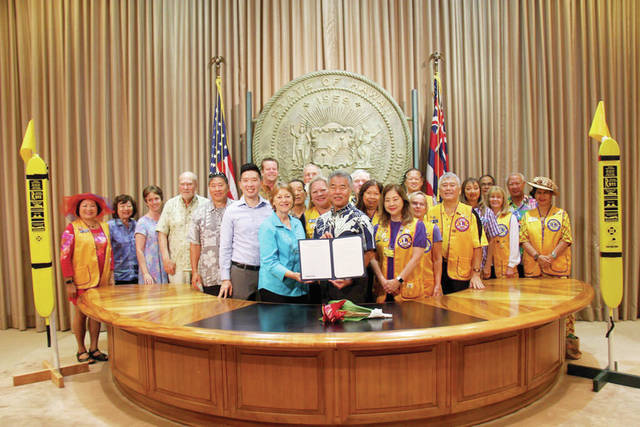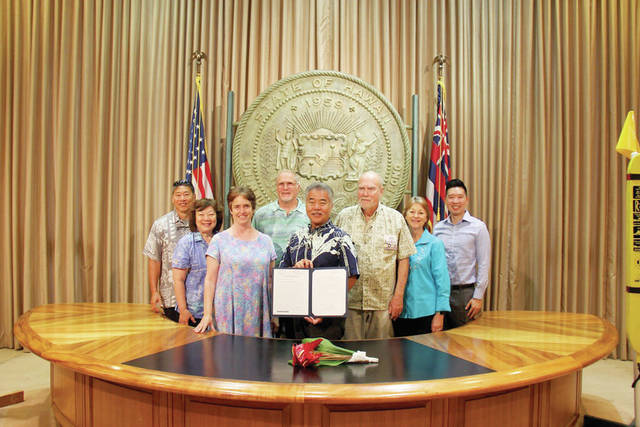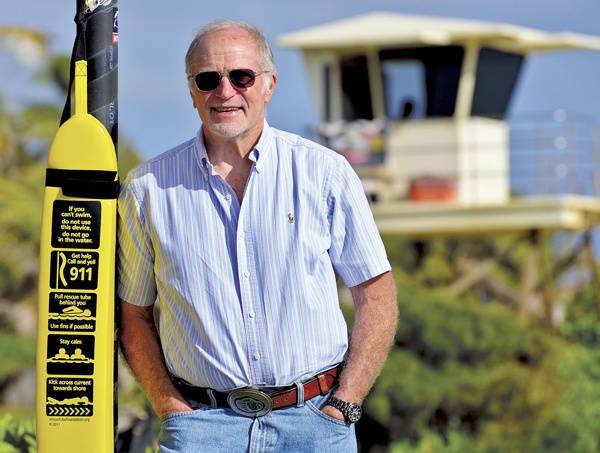LIHUE — Rescue tubes save lives, but some have been leery of using them or hosting one on their property because of a liability potential should an ocean rescue attempt go wrong.
That concern was put to rest thanks to Gov. David Ige’s July 6 signing of SB 2087, which provides civil liability exemptions for people who “in good faith, without compensation or expectation of compensation, attempt to rescue a person with a rescue tube.”
The new law also protects owners and operators of any premises, property or facility where rescue tubes are located.
“This new law basically grants immunity to property owners who choose to have a rescue tube stationed on their property,” said Dr. Monty Downs, president of the Kauai Lifeguard Association. “This bill should eliminate fears and should allow for more rescue tubes to be placed.”
Ige said the ability to have rescue tubes available and protect the landowners and anyone who would want to use them to save somebody was something the state should encourage.
“We cannot have lifeguards 24 hours day at every single point of ocean entry, it’s impossible,” he said. “We do know that with the vibrancy of social media our guests are finding more and more areas to visit, even when we don’t encourage them.”
The law protects good Samaritans who help people who get into trouble in the water.
Ige and bill introducer Sen. Stanley Chang both acknowledged Downs for populating Kauai’s beaches with rescue tubes and the many supporters of the rescue tube program for helping expand it to Maui and the Big Island.
Landowners on Oahu were wary of the idea, Chang said, and that’s where the idea of eliminating liability came from.
“A lot of landowners weren’t comfortable hosting these,” he said. “It took a fantastic grassroots effort.”
The first rescue tube was hung on a shrub at Larsen’s Beach in 2007 by John Tyler, according to Downs, and in the past 10 years 163 people have been assisted by good Samaritans using rescue tubes.
“Analyzing these events in detail, it’s clear that at least two dozen out of these 163 would have died for sure,” Downs said. “The other 140 or so might or might not have died, but the rescue tubes sure come in handy.”
Downs said placing the rescue tubes on Kauai hasn’t been too much of a problem, but landowners on other islands resisted the idea. The bill fixes that.
“Yes, that will mean more lives saved, more families saved, more catastrophes averted,” Downs said.
The tubes are basic flotation devices with straps — akin to those used by lifeguards.
“The novelty of a rescue tube program lies in having them be readily available to beachgoers on remote and unguarded beaches, or on lifeguarded beaches after hours,” Downs said.
He points out written on every device is a statement that directs people not to use them if they can’t swim.
Branch Lotspeich, executive director of the Rescue Tube Foundation, says the change will save lives.
There are rescue tubes on all of the Hawaiian Islands and in North Carolina, Florida, South Dakota and California.
“The program is just beginning,” he said. “I am so proud of what we have started on Kauai and to now of the recognition of the Hawaii Senate and the House and the governor is an amazing honor for Kauai.”
The rescue tubes have been a beneficial program, but it doesn’t work if people aren’t willing to use them, volunteers who are willing to purchase and set them up, and people who are willing to maintain them.




